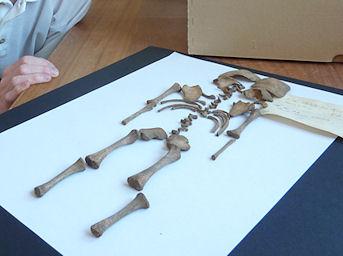
The ancient Romans slaughtered dozens of babies at a villa in England’s Thames Valley, a new study into the tiny remains has revealed.
Located in Buckinghamshire, just northwest of London, Yewden Villa, as the site is known, was excavated in 1912 by Alfred Heneage Cocks, a naturalist and archaeologist.
Now a wheat field, the site was almost forgotten.
Archaeologists began investigating it only recently, as Cocks’ original report was rediscovered at Buckinghamshire County Museum, along with 300 boxes containing photographs, artifacts, pottery and bones.
Indeed, Cocks’ excavations produced a number of unusual discoveries, including a very high number of iron styli — pens for writing on wax tablets — as well as several corn-drying kilns.
But what intrigued the researchers were the tiny skeletons.
“There were 97 infant skeletons on the site. They were mostly buried in a yard area, although several were found in rubbish pits, two below the floor of a house and one placed in a wall cavity,” archaeologist Jill Eyers, director of Chiltern Archaeology, told Discovery News.
Measurements of the bones showed that all the babies died at around 40 weeks gestation, very soon after birth. The finds suggests “this may be an example of deliberate infanticide,” the Buckinghamshire County Council said in a statement.
“It would be normal to find infant burials within a Roman villa enclosure, but they would have an age range from premature births up to 2 years of age. After 2 years of age, they were deemed to be a ‘full person’ and were then buried in the cemetery,” Eyers said.
According to the researchers, the date these deaths occur spread out over just a 50 years, between 150 and 200. No apparent deformities were noted on the remains.
One possibility is that the newborns could have been the unwanted babies of prostitutes. The villa was occupied for several hundred years, and there is a theory that for part of that time, it may have been a brothel.
“Babies would be a common occurrence in this profession,” said Eyers. “Most of them would not be wanted. There are other ideas we are considering though.”
“It may may also have been a site for ritual or religious killing. A colleague has recently suggested a birthing center for a large working population in the surrounding area,” she added.
Another theory is that the villa was an Imperial supply depot, with a lot of literate and numerate workers (explaining the large numbers of iron styli), perhaps processing grain (explaining the corn drying kilns).
The large number of deliberately killed babies may relate to wanting to keep the mothers at work, rather than having to care for the children.
“We are still investigating the bones. We will look more closely at any potential source of natural perinatal death and use DNA analysis to detect the sex of the infants and to see if they are related,” Eyers said.
The investigation will feature in a new BBC archeology television series called “Digging for Britain.”
http://news.discovery.com/history/unwanted-babies-haunt-roman-era-g…
